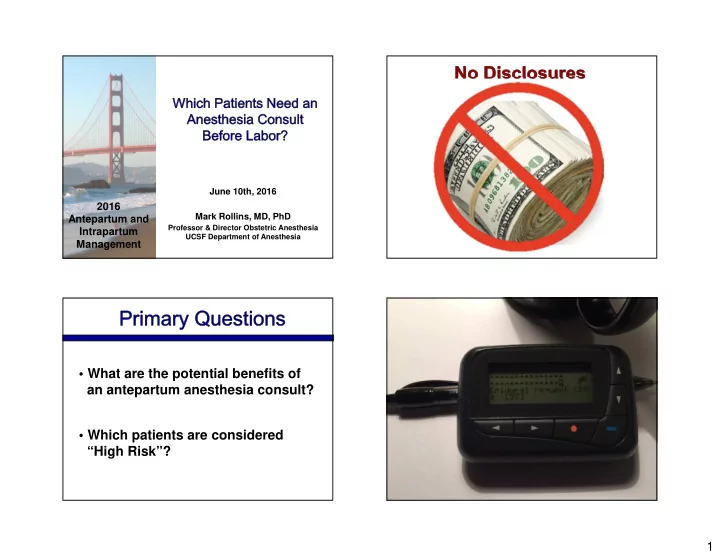

June 10th, 2016 2016 Mark Rollins, MD, PhD Antepartum and Professor & Director Obstetric Anesthesia Intrapartum UCSF Department of Anesthesia Management UC SF • What are the potential benefits of an antepartum anesthesia consult? • Which patients are considered “High Risk”? 1
…The chart says the patient has HHT…What’s that? …Is that a …I don’t think I have pacemaker? any bleeding …Oh that, its just an problem, ICD …but my mother has von Something… 2
http://www.cdc.gov/reproductivehealth/maternalinfanthealth/pmss.html Causes of pregnancy-related death in the United States: 2006–2010 Malcom Gladwell Creanga AA, et al. Obstet Gynecol. 2015; 125: 5-12 Creanga AA, et al. Obstet Gynecol. 2015; 125: 5-12 3
Provider Contributing Factors in Maternal Deaths (California) From detailed chart reviews of maternal deaths (CA-Pregnancy Associated Mortality Review Committee; CDPH-MCAH) Main EK, McClain CL, Morton CH, Holtby S, Lawton ES. Pregnancy-related mortality in California: Causes, characteristics and improvement opportunities. Obstet Gynecol 2015 The recognition and “ Careful clinical planning and management of severe, acute management may decrease the illness in a pregnant woman likelihood of high-risk obstetric requires multidisciplinary patients developing life-threatening teamwork. conditions and severe maternal An anaesthetist and/or critical- morbidity or mortality.” care specialist should be involved early. 4
BMJ. December 2003 Anesthesiology. 2016; 124(2): 1-31 • Recognition of significant anesthetic or obstetric risk factors should encourage consultation between the obstetrician and the anesthesiologist • A communication system should be in place to encourage early and ongoing contact between obstetric providers, anesthesiologists, and other members of the multidisciplinary team Why in the antepartum period? Other Potential Benefits? • Timely input from senior specialists • Decrease complications • Further studies may be required • Improve efficiency / limit delays • Need for additional subspecialists • Improve patient communication • Coordination of labor care • Improve patient satisfaction • Discussion of options / special needs • Useful teaching opportunity for patients • Potential need for transfer • Closer specialty working relationship A. Butwick et al. IJOA 2007; 16:311 A. Butwick et al. IJOA 2007; 16:311 5
What is the Best Model? • High Risk Clinic? What warrants a consult? • Scheduled time in triage? • Phone consult? • Page anesthesiologist on call? • While patient in labor? What warrants a consult? What warrants a consult? 6
Cardiovascular Disease: Cardiovascular Disease (continued): • Congestive Heart Failure • Presence of pacemaker or ICD • Myocardial ischemic disease • Cardiomyopathy • H/O Congenital Heart Defect • History of cardiac arrhythmia • Pulmonary Hypertension • Valvular Heart Disease • Aortic Aneurysm Moderate or Severe Aortic Stenosis • Prior Cardiac Surgery Moderate or Severe Mitral Regurg Pulmonary Stenosis Respiratory Disease • Hematologic Disease • VonWillebrands • Asthma requiring daily medications or Hx of hospitalization in past year • Thrombocytopenia (<100K) • Hemophilia • Interstitial lung disease • ITP • Cystic Fibrosis • Hemoglobinopathy • Pulmonary Fibrosis • Other coagulopathy • Need for home oxygen • Currently on anticoagulation • Pulmonary Hypertension 7
Neurologic/ Musculoskeletal Obstetric Considerations: • History of Stroke • Triplets or greater multiple gestations • Scoliosis or other spinal deformity or disease • Prior Spine or Brain Surgery • BMI greater than 45 • Chiari Malformation • Planned EXIT procedure • Multiple Sclerosis • Suspected Accreta / Percreta • Myasthenia Gravis • Neurofibromatosis • Need for Non-Obstetric Surgery • Elevated ICP or presence of LP shunt • Neurovascular aneurysm / AV malformation • Other Anesthesia Considerations: • Sleep Apnea • Prior severe drug reactions / allergies • Chronic Pain • Previous problems with difficult airway • Current Cancer • Previous problems with malignant • Liver Cirrhosis • Severe endocrine disease hyperthermia • Autoimmune SLE • Age > 50 • Previous problems with epidurals or • Any patient with significant concerns spinals • Refuses of blood transfusion • Learning difficulties or inability to consent • Any patient deemed “High Risk” by Obstetrician 8
Can J. Anesth 2014: 61:282 Francis & Yentis (2005); Women’s Health Medicine 2:4 SUMMARY: Top 3 Referrals: • Early identification & consultation • Cardiac • Timely investigation • Musculoskeletal • Prompt request for referrals • Hematologic • Planned management for both scheduled and emergent delivery …..That leaves 40 -50% • Involvement of a multi-disciplinary team • Obesity? Goal to minimize morbidity & mortality Can J. Anesth 2014: 61:282 9
Recommend
More recommend